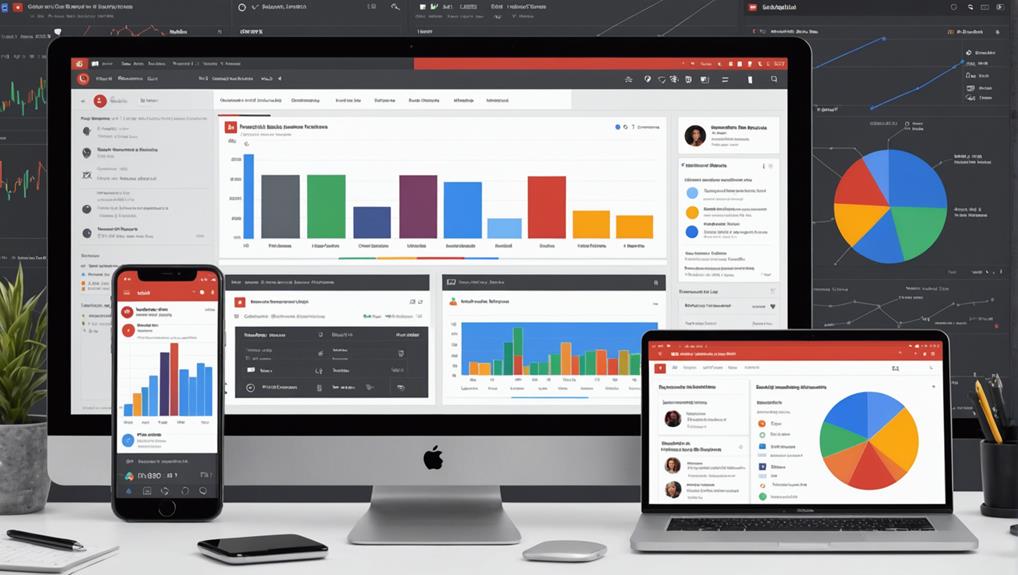Maximizing YouTube ad revenue involves strategic planning around content and audience engagement. Longer watch times, video lengths exceeding 8 minutes for mid-roll ads, and optimizing CPM rates through understanding audience demographics are key drivers. High-quality content that sustains viewer retention enhances revenue potential, as does targeting affluent or older demographics who attract higher CPMs. Effective mid-roll ad placement, often during engaging segments, further boosts earnings. Continuous analysis through YouTube Analytics informs content optimization and aligns with viewer and advertiser interests. Analyzing these factors strategically can greatly enhance your channel’s ad revenue and open avenues for deeper exploration.
Key Takeaways
- Longer watch time boosts ad exposure, enhancing revenue potential.
- Videos over 8 minutes can include mid-roll ads, increasing revenue.
- High CPM rates are achieved with affluent or older audience demographics.
- Effective mid-roll ad placement during engaging moments maximizes viewer retention and revenue.
- Analyzing audience demographics optimizes content for higher-value segments, increasing ad revenue.
Key Drivers of Ad Revenue
Understanding the key drivers of ad revenue on YouTube is essential for content creators aiming to optimize their earnings. Watch time emerges as a pivotal factor; longer viewer engagement not only increases ad exposure opportunities but also signals quality content to YouTube’s algorithm, promoting further visibility.
Strategically, enhancing watch time can lead to sustained audience retention, subsequently boosting ad revenue.
Video length is another vital component. Videos exceeding 8 minutes can incorporate mid-roll ads, a strategy proven to greatly increase earnings. Empirical evidence suggests that videos over 10 minutes can potentially generate three times more revenue than their shorter counterparts. This underlines the importance of creating content that is both engaging and appropriately lengthy.
CPM rates vary greatly based on content type and audience demographics. Channels focusing on high-competition niches such as e-commerce and finance tend to attract higher CPM rates, enhancing revenue potential.
Additionally, channels with audiences in affluent regions or older demographics often command higher CPM rates.
Optimizing Video Content
How can content creators effectively optimize their video content to maximize ad revenue on YouTube? A strategic approach begins with investing in high-quality filming equipment and mastering editing software. This enhances visual appeal, vital for maintaining an engaged audience. High resolution and optimized lighting guarantee that videos are presented at their best across all devices, directly influencing viewer satisfaction and audience retention.
These factors are significant, as longer watch times positively impact the YouTube algorithm, which favors content that retains viewers.
Creating compelling narratives is another important component. Content that resonates with viewers not only boosts watch time but also encourages repeated engagement, increasing the potential for ad revenue. Techniques such as end screens and annotations further engage viewers, prompting them to explore additional content and subscribe, thereby expanding channel engagement and ad opportunities.
Consistency in producing high-quality content that aligns with viewer preferences, informed by YouTube Analytics, attracts high-paying advertisers. This data-driven approach allows content creators to refine their strategy, guaranteeing alignment with audience interests and enhancing ad strategy effectiveness.
Ultimately, optimizing video content by focusing on quality and engagement is essential for maximizing YouTube ad revenue.
Understanding Audience Demographics
Identifying audience demographics is vital for content creators aiming to maximize their ad revenue on YouTube. By analyzing data about the age, gender, and location of viewers, creators can strategically align their content with high-value audience segments. Older demographics, for instance, typically generate higher advertising revenue due to their increased spending power. Consequently, targeting this age group can lead to boosted CPM (Cost Per Mille) and RPM (Revenue Per Mille) rates, enhancing overall monetization potential.
Geographic trends further influence ad revenue outcomes. Content that appeals to viewers in affluent regions tends to command higher CPM rates, as advertisers are willing to pay a premium to reach these lucrative markets. Therefore, creators should consider tailoring their content to align with these geographic preferences to optimize revenue.
Gender preference analysis also plays a significant role in shaping content strategy. By understanding how different genders engage with advertisements, creators can enhance viewer interaction and, subsequently, advertising revenue. High-paying advertisers are more likely to invest in channels that reflect their target audience demographics, underscoring the importance of demographic alignment.
Consistent content production, coupled with strategic tagging, guarantees discoverability among targeted demographics, sustaining traffic and driving ad revenue growth.
Strategic Ad Placement
In the context of optimizing YouTube ad revenue, strategic ad placement is pivotal, with effective mid-roll integration playing a critical role in enhancing viewer retention and engagement for longer video formats.
By balancing ad frequency, content creators can maximize viewer watch time while mitigating the risk of audience drop-off.
Additionally, leveraging seasonal content opportunities allows creators to capitalize on higher CPM rates, as advertisers are more inclined to increase bids during peak periods, thereby boosting revenue potential.
Effective Mid-Roll Integration
Strategically integrating mid-roll ads within YouTube videos longer than eight minutes presents a significant opportunity for creators to boost revenue and enhance viewer retention. By utilizing mid-roll ads, creators can benefit from additional ad placements that do not disrupt the audience engagement flow.
The key lies in placing these ads at high-energy or engaging moments, as data suggests that viewers are less inclined to skip ads during enthralling segments. This approach not only maximizes revenue potential but also maintains viewer retention, essential for sustained audience growth.
Experimentation with mid-roll ad placements is important to identify ideal points for viewer engagement. Analyzing audience retention data during these ads can reveal insights into viewer behavior and preferences, guiding creators in refining their strategies.
However, balance is critical; excessive ad frequency can lead to viewer drop-off, diminishing the overall effectiveness of the strategy. Creators must strike an equilibrium that maximizes ad exposure while preserving the viewing experience.
Furthermore, post-implementation analysis of viewer feedback and engagement metrics is significant. This ongoing evaluation guarantees that ad placements resonate with audience preferences, allowing for continuous improvement.
Ultimately, effective mid-roll integration hinges on data-driven decision-making and strategic ad placement.
Seasonal Content Opportunities
Capitalizing on seasonal content opportunities presents a strategic pathway for YouTube creators aiming to enhance ad revenue. During peak shopping periods, such as Christmas or Black Friday, advertisers demonstrate heightened interest, leading to raised CPM rates. This increased advertiser interest can considerably boost ad revenue for creators who effectively tailor their content to these seasonal trends. By aligning videos with major holidays, creators not only attract a larger audience but also engage viewers more effectively through relevant ads.
One method to leverage seasonal content is the strategic placement of mid-roll ads in longer videos. This strategy maximizes monetization opportunities by capitalizing on the natural increase in viewer retention during festive periods. Additionally, monitoring seasonal trends allows creators to anticipate fluctuations in advertiser interest, thereby optimizing their content strategies for maximum revenue potential.
| Seasonal Period | CPM Rate Increase | Viewer Engagement |
|---|---|---|
| Christmas | High | Very High |
| Black Friday | Moderate | High |
| Halloween | Moderate | Moderate |
| Valentine’s Day | Low | Moderate |
| Easter | Moderate | Moderate |
Optimal Frequency Balance
Effective ad placement is paramount for maximizing revenue on YouTube, particularly when it comes to balancing the frequency of mid-roll ads in longer videos. An ideal frequency balance guarantees that ad frequency does not disrupt the viewing experience, thereby maintaining viewer engagement.
Strategic ad placements during peak watch times capitalize on heightened engagement, making it essential to analyze audience retention graphs for informed decision-making.
Balancing ad frequency involves a nuanced understanding of viewer behavior. Overloading videos with ads can lead to viewer fatigue and potential drop-off, adversely affecting both engagement and revenue. Conversely, too few ads may not fully capitalize on revenue potential. This necessitates a consistent pattern of experimentation and analysis to pinpoint the perfect ad frequency.
Moreover, the relevance of ads to the video’s content greatly enhances viewer retention rates. Ads that align closely with the interests and themes of the video can improve engagement, as audiences are more receptive to pertinent content.
Continuous testing of different ad formats and placements allows creators to tailor strategies to their audience’s preferences, ultimately driving higher ad revenue. Through data-informed adjustments, creators can refine viewer engagement and revenue simultaneously.
Leveraging Analytics
In the pursuit of maximizing YouTube ad revenue, leveraging analytics is paramount to understanding viewer demographics and shaping an optimized content strategy.
By analyzing engagement metrics, creators gain insights into viewer preferences, enabling them to refine their video offerings for enhanced retention and monetization.
Strategic use of such data guarantees content aligns with audience interests, while also adapting to shifts in advertiser demand, thereby sustaining and potentially increasing revenue streams.
Understanding Viewer Demographics
Understanding viewer demographics is essential for optimizing ad revenue on YouTube, as it provides a data-driven foundation for strategic content and advertising decisions. Analyzing viewer demographics through YouTube Analytics reveals critical insights such as age, geographic location, and gender, which greatly affect ad revenue potential.
Older age groups often correlate with higher spending power, making them attractive to advertisers and leading to increased ad rates. This demographic tends to engage more with premium content, further enhancing revenue opportunities.
Geographic trends also play a pivotal role, as audiences from affluent regions like the US and Canada typically yield higher CPM rates. This disparity highlights the importance of targeting content to regions where viewers have greater spending capabilities.
Gender distribution analysis adds another layer of strategic insight, allowing creators to align content with specific advertiser interests, thereby broadening revenue opportunities.
Utilizing YouTube Analytics to monitor these demographic patterns enables creators to tailor their content and advertising strategies effectively. By understanding who their audience is and where they are located, creators can maximize monetization potential.
Consistent content production combined with strategic demographic targeting can greatly enhance discoverability and viewer engagement, ultimately driving higher ad revenue.
Optimizing Content Strategy
A robust content strategy on YouTube hinges on the strategic use of analytics to optimize viewer engagement and ad revenue. By leveraging YouTube Analytics, creators can dissect audience attention through detailed insights into viewer demographics and behaviors. This data-driven approach allows content to be tailored specifically to resonate with the target audience, subsequently increasing engagement metrics such as watch time and audience retention.
Understanding these metrics is essential for refining content strategies that captivate viewers longer, thereby enhancing the potential for ad placement optimization.
Furthermore, analytics reveal important information about traffic sources, providing creators with an extensive view of where their views originate. This knowledge is instrumental in devising promotion strategies that extend content reach across high-impact platforms, driving higher ad revenue potential.
Additionally, click-through rates offer a precise measure for evaluating the effectiveness of ad placement, guaranteeing that advertisements are displayed in contexts that maximize viewer interaction and, consequently, revenue.
Monitoring seasonal trends through YouTube Analytics enables creators to anticipate shifts in viewer interests and advertiser demand, allowing for proactive content adjustments. This strategic foresight guarantees that content remains relevant and revenue opportunities are maximized, maintaining a competitive edge in the dynamic YouTube landscape.
Analyzing Engagement Metrics
Delving into the domain of engagement metrics is essential for creators aiming to refine their YouTube strategy and bolster ad revenue. YouTube Analytics offers invaluable insights into viewer demographics and behaviors, empowering creators to tailor content and promotional strategies effectively. Key engagement metrics such as watch time and audience retention rates serve as critical indicators of content quality. High watch time not only signals to YouTube’s algorithm that the content is valuable but also increases its visibility, thereby enhancing potential ad revenue.
Furthermore, click-through rates (CTR) on video thumbnails and titles play a pivotal role in driving viewer engagement. Raised CTRs are often indicative of compelling content presentation, which can lead to increased views and watch time—ultimately resulting in enhanced ad revenue opportunities. Analyzing traffic sources further aids creators in understanding viewer origination, facilitating the optimization of promotional efforts and improving content discoverability.
Consistent tracking of these engagement metrics allows creators to discern which content types resonate most with their audience. This data-driven approach guides future content creation, ensuring alignment with viewer interests and maximizing ad revenue potential.
Strategic leveraging of analytics transforms viewer insights into actionable strategies that raise YouTube success.
Diversifying Revenue Streams
Maximizing revenue on YouTube extends beyond traditional ad earnings, as savvy creators strategically diversify their income streams to bolster financial sustainability. By integrating exclusive content, affiliate marketing, and sponsorships into their monetization strategy, creators can greatly enhance their overall earnings.
Merchandise sales and membership programs that offer exclusive benefits are effective methods to diversify revenue streams. These approaches not only foster viewer loyalty but also increase engagement, leading to higher subscription-based income.
- Merchandise and Exclusive Content: Offering unique products or exclusive content can create a new revenue channel while strengthening viewer connection and loyalty.
- Affiliate Marketing: By promoting relevant products and services, creators can earn commissions, providing a supplementary income source that complements ad revenue.
- Sponsorships: Collaborating with brands for sponsored content can attract lucrative deals, especially if the channel aligns with the brand’s target audience.
Creators who tap into seasonal trends and produce themed content can attract advertisers seeking to leverage specific consumer spending periods, thereby expanding their revenue potential.
In addition, platforms like Patreon allow creators to receive direct support from fans, mitigating reliance on fluctuating ad revenues and fostering a stable, diversified income ecosystem.
Enhancing Viewer Engagement
To enhance viewer engagement on YouTube, creators must strategically employ data-driven techniques that align with platform algorithms and audience preferences. Engaging content that resonates with viewers is paramount, as it considerably raises watch time—a vital factor in boosting ad revenue. Longer watch times signal quality content to YouTube’s algorithm, thereby increasing the likelihood of ad exposure.
Utilizing features like end screens and annotations encourages viewers to subscribe and explore additional videos, ultimately enhancing viewer retention and session time.
Incorporating compelling narratives and storytelling is another effective strategy that fosters a deeper connection with the audience. This approach not only boosts viewer engagement but also provides more opportunities for ad exposure, particularly when strategic ad placements are employed. Implementing mid-roll ads in longer videos can maximize revenue potential without causing viewer drop-off, consequently maintaining a seamless viewing experience.
Regular analysis of viewer demographics and engagement metrics is essential for tailoring content to audience preferences. By understanding these parameters, creators can cultivate increased viewer loyalty, which translates into higher ad revenue.
Therefore, a strategic focus on enhancing viewer engagement through tailored content and ideal ad placements is vital for maximizing YouTube ad revenue.
Frequently Asked Questions
What Increases Youtube Revenue?
Increasing YouTube revenue involves enhancing audience engagement and ensuring video quality. Strategic niche selection and maintaining content consistency are pivotal, as they attract higher CPM rates and sustained viewer interest, directly influencing monetization success through optimized algorithmic visibility.
What Determines Youtube Ad Revenue?
YouTube ad revenue is determined by viewer demographics, audience engagement, and content quality. Strategically placed ads, particularly in longer videos, enhance revenue. Channels targeting affluent regions with high engagement and quality content benefit from increased ad placement opportunities.
What Topics on Youtube Generate the Most Ad Revenue?
Topics generating the most YouTube ad revenue include finance, technology, health, beauty, and education. Strategic niche selection, coupled with high audience engagement, superior content quality, and ideal video length, greatly enhances monetization potential within these competitive sectors.
Why Is My Youtube Ad Revenue so Low?
Low YouTube ad revenue typically stems from suboptimal ad formats, insufficient viewer engagement, poor niche selection, and inadequate content quality. Strategically enhancing these elements can considerably improve revenue outcomes by boosting watch time and optimizing ad exposure opportunities.
Conclusion
Increased YouTube ad revenue is primarily driven by optimizing video content for algorithmic preferences, understanding audience demographics to tailor content effectively, and strategically placing ads to maximize viewer retention and engagement. Leveraging analytics provides insights into performance metrics, enabling data-driven decisions that enhance ad efficacy. Diversifying revenue streams reduces dependency on ads alone, while enhancing viewer engagement fosters a loyal audience base, further increasing monetization potential. Together, these strategies form an all-encompassing approach that boosts ad revenue.




